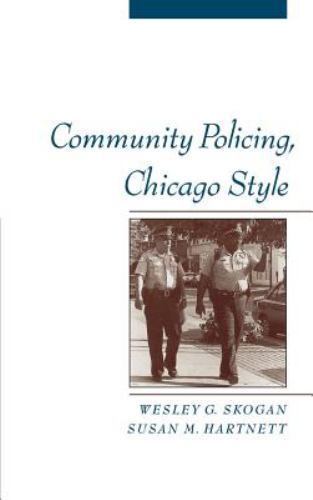Picture 1 of 1

Stock photo

Picture 1 of 1

Stock photo

Studies in Crime and Public Policy Ser.: Community Policing, Chicago Style by Wesley G. Skogan and Susan M. Hartnett (1997, Hardcover)
A
adg2928 (362)
100% positive feedback
Price:
$10.00
+ $5.22 shipping
Returns:
Condition:
Brand new condition, hard cover with jacket.
Oops! Looks like we're having trouble connecting to our server.
Refresh your browser window to try again.
About this product
Product Identifiers
PublisherOxford University Press, Incorporated
ISBN-100195105605
ISBN-139780195105605
eBay Product ID (ePID)832797
Product Key Features
Number of Pages272 Pages
Publication NameCommunity Policing, Chicago Style
LanguageEnglish
SubjectLaw Enforcement, Criminology, Sociology / Urban
Publication Year1997
TypeTextbook
AuthorWesley G. Skogan, Susan M. Hartnett
Subject AreaPolitical Science, Social Science
SeriesStudies in Crime and Public Policy Ser.
FormatHardcover
Dimensions
Item Height1.2 in
Item Weight20.2 Oz
Item Length6.3 in
Item Width9.3 in
Additional Product Features
Intended AudienceCollege Audience
LCCN96-027841
Reviews"Skogan and Harnett offer here yet another exemplary, extraordinary study that incorporates both fascinating particulars and generalizable findings. It is well-designed and subtly orchestrated and should become required reading in the social sciences. Not only is it engaging and clearly written, it contains hopeful notes about the future of urban policing...Community Policing, Chicago Stylemasterfully sets out an experimental design, identifies the elements of the program, asserts a logical model by which program and results are connected, presents abundant data clearly, and is cautious about generalization and modest about findings."--Americal Journal of Sociology, "Skogan and Harnett offer here yet another exemplary, extraordinary studythat incorporates both fascinating particulars and generalizable findings. It iswell-designed and subtly orchestrated and should become required reading in thesocial sciences. Not only is it engaging and clearly written, it containshopeful notes about the future of urban policing...Community Policing, ChicagoStyle masterfully sets out an experimental design, identifies the elements ofthe program, asserts a logical model by which program and results are connected,presents abundant data clearly, and is cautious about generalization and modestabout findings."--Americal Journal of Sociology, "Skogan and Harnett offer here yet another exemplary, extraordinary study that incorporates both fascinating particulars and generalizable findings. It is well-designed and subtly orchestrated and should become required reading in the social sciences. Not only is it engaging and clearly written, it contains hopeful notes about the future of urban policing...Community Policing, Chicago Style masterfully sets out an experimental design, identifies the elements of the program, asserts a logical model by which program and results are connected, presents abundant data clearly, and is cautious about generalization and modest about findings."--Americal Journal of Sociology, "Skogan and Harnett offer here yet another exemplary, extraordinary study that incorporates both fascinating particulars and generalizable findings. It is well-designed and subtly orchestrated and should become required reading in the social sciences. Not only is it engaging and clearly written, it contains hopeful notes about the future of urban policing... Community Policing, Chicago Style masterfully sets out an experimental design, identifies the elements of the program, asserts a logical model by which program and results are connected, presents abundant data clearly, and is cautious about generalization and modest about findings."-- Americal Journal of Sociology, "Skogan and Harnett offer here yet another exemplary, extraordinary study that incorporates both fascinating particulars and generalizable findings. It is well-designed and subtly orchestrated and should become required reading in the social sciences. Not only is it engaging and clearly written, it contains hopeful notes about the future of urban policing...Community Policing, Chicago Style masterfully sets out an experimental design, identifies theelements of the program, asserts a logical model by which program and results are connected, presents abundant data clearly, and is cautious about generalization and modest about findings."--Americal Journal ofSociology"Skogan and Harnett offer here yet another exemplary, extraordinary study that incorporates both fascinating particulars and generalizable findings. It is well-designed and subtly orchestrated and should become required reading in the social sciences. Not only is it engaging and clearly written, it contains hopeful notes about the future of urban policing...Community Policing, Chicago Style masterfully sets out an experimental design, identifies theelements of the program, asserts a logical model by which program and results are connected, presents abundant data clearly, and is cautious about generalization and modest about findings."--Americal Journal ofSociology, "Skogan and Harnett offer here yet another exemplary, extraordinary study that incorporates both fascinating particulars and generalizable findings. It is well-designed and subtly orchestrated and should become required reading in the social sciences. Not only is it engaging and clearlywritten, it contains hopeful notes about the future of urban policing...Community Policing, Chicago Style masterfully sets out an experimental design, identifies the elements of the program, asserts a logical model by which program and results are connected, presents abundant data clearly, and iscautious about generalization and modest about findings."--Americal Journal of Sociology
Dewey Edition20
IllustratedYes
Dewey Decimal363.2/3
SynopsisPolice departments across the country are busily "reinventing" themselves, adopting a new style known as "community policing". This approach to policing involves organizational decentralization, new channels of communication with the public, a commitment to responding to what the community thinks their priorities ought to be, and the adoption of a broad problem-solving approach to neighborhood issues. Police departments that succeed in adopting this new stance have an entirely different relationship to the public that they serve. Chicago made the transition, embarking on what is now the nation's largest and most impressive community policing program. This book, the first to examine such a project, looks in depth at all aspects of the program--why it was adopted, how it was adopted, and how well it has worked., Police departments across the USA are busily "reinventing" themselves, adopting a new style known as "community policing". Police departments that succeed in adopting this new stance have an entirely different relationship to the public that they serve. Chicago made the transition, and this book examines why it did, how it did it, and how well it worked.
LC Classification NumberHV7936.C83S56 1997
All listings for this product
Be the first to write a review



























